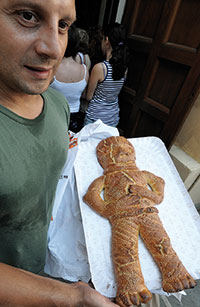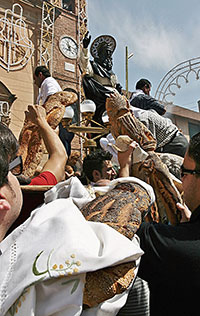The Bread Men
Anthropomorphic votive offerings at Italian festivals
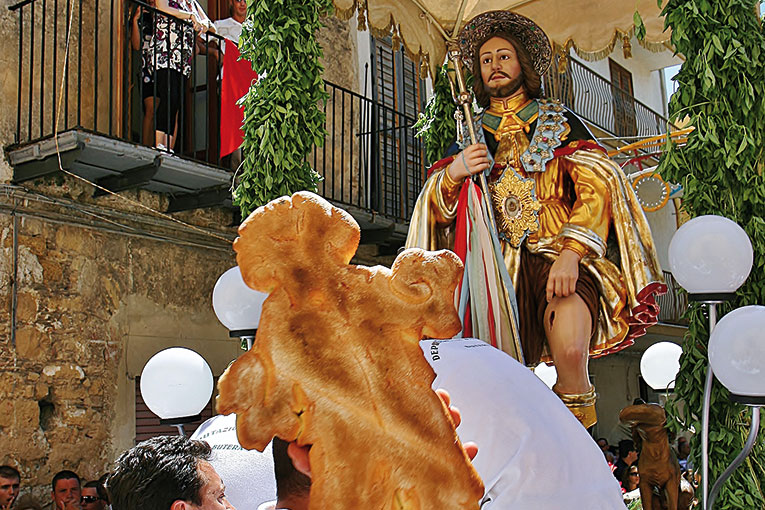
|
Many festivals held in Italy feature ceremonial bread as an offering. The presence of votive breads, sometimes made in human form, is widespread in several regions. In Sicily one can still encounter a wide range of ceremonial breads, in particular during the festivities celebrating Saint Joseph and Easter. These «special» breads are also given as offerings during many other festivals and celebrations of special relevance to particular communities. Given their shape and ritual use, anthropomorphic breads are of particular interest, which are ex-votives proffered to restore order in the body and the cosmos. Premise More often than it is generally believed, myths –like rituals– are deeply rooted in the territories, landscapes and also in the history that has shaped and transformed these lands and landscapes. It may be true that the incisive power of myths often ends up hiding whole facets of the surrounding reality, prompting attention to be paid to some aspects alone; however, there is no doubt that Italy –particularly the south and its islands– has been one of the most privileged cereal-growing Mediterranean regions for millennia. Thus, this occupation can be considered as one of the main clues to interpreting the history and culture –ancient and modern– of this land. Like any Mediterranean area, Italian history –involving encounters and conflicts between peoples, revolts within communities or social classes, and the rise and fall of individuals and social groups– was largely an immediate consequence of the struggle to control these cereal-growing areas, and to trends in cereal production. Therefore, socio-anthropological research cannot fail to consider how world views, social organisations, forms of material culture or mythical imagery and ritual all lived cheek by jowl with wheat. Society was built on the vicissitudes of this cereal and its derivatives: first came bread, the result of an ergologic process whose activity, phases and critical moments regulates the pace and ways of community life, with the most important festivals on the ceremonial calendar being arranged around the agricultural growing cycles, particularly of cereals (Buttitta, 2006). The value of bread Desired, sought after, disputed… bread was, and largely is, a vital element in the diet of both the rich and poor: real and genuine essence –hypostasis if you will– of food in both symbolic and nutritional terms. It is enough to recall, on the one hand, the gestures and words that preceded and accompanied the preparation and consumption of bread, and how they became ritualised bearers of widely transcendent meaning of nutritional value and, on the other, how bread has been used in festive contexts, either in its simplest form or elaborately sculpted. Cosmopoetic and cosmological metaphor, synthesis of each creative transformation and every life cycle, the history of bread –from the grain to the finished product– passes through the whole human history and life cycle: birth, life, death, rebirth; a dialect between immanence and transcendence, like that existing between nature and culture. Harvested, threshed and winnowed, kneaded, blessed, proffered during Holy Mass, adored, divided and distributed, consumed at different times and in a variety of ways, one might say that bread is to be found in our sacred vocabulary, like a sememe of special significance in rituals, an extremely multifunctional element, whose valences are redefined from time to time depending on the specific symbolic value attached to different contexts of use. Contexts, it should be noted, that generally undergo processes of social and economic change, and the pressures of economic and institutional forces, which are often endogenous and sometimes traumatic, which impose social processes upon the players that redefine and re-cipher ritual practices and symbols. Bread and festivals Italian ceremonial bread, including votive bread figures in particular, has been the subject of numerous studies. Votive bread, sometimes anthropomorphic figures, can be found in Abruzzo, Latium, Basilicata, Calabria, Apulia and Sardinia, among other regions (Rossi, 1971; Cirese et al., 1973; Cavalcanti, 1995; Faeta, 1987 and 2000). In Sicily, a wide range of ceremonial breads is still to be found, particularly during the festivities of around San Jose (Saint Joseph) and Easter (Giallombardo, 2006; Rufino, 1995). These «special» breads are also associated with other festivals like Santa Lucia or San Biagio (Saint Blaise) or many celebrations of particular relevance to specific towns or communities such as San Calogero, San Sebastiano, Santissimo Crocifisso (Uccello, 1976; Buttitta and Cusumano, 1991). Today we can see what Giuseppe Pitrè (1913) reported in the early twentieth century, namely that in almost every village on the island, devozioni –blessed bread of devotion– is made to give thanks for grazia prayed for, or the fulfilment of vows made (1913:183). Regardless of the wide variety of breads, so huge as to test any rigorous attempt at classification, here we look at one particular kind, anthropomorphic votive bread offerings, which although found in several regions of Italy, have not been thoroughly studied or analysed in Sicily. Anthropomorphic votive bread offerings in Sicily The votive offerings that take the more or less stylised –but always recognisable– shape of the human body, albeit partial sometimes, are offerings that devotees proffer to a saintly thaumaturge to give thanks or –more rarely– to pray for healing. These offerings are primarily and publically made in testimony to the fulfilment of vows made. Like any other ex-votes, bread figures are meant to represent, on the one hand, a proof, a story of miraculous healings, and on the other, a gift, as evidence of giving up something in favour of the saint and of the sacrifice made. Indeed, in the case of votive offerings, it is not so much the intrinsic value of the object, which perhaps lacks monetary value (although in a not too distant past, bread was a coveted food and not always present on the peasant’s table), but rather the whole process, from production to donation: just think of the journey undertaken by the one making the offering, a bodily munus. A history and a need are, therefore, mingled within the votive bread: the individual history of a restructuring of bodily order, the need of divine intervention for this to be achieved. Both the essence (the bread) and the ritual use of these offerings call for deeper interpretation. |
«The gestures and words that accompanied the preparation and consumption of bread are ritualised and have become bearers of largely transcendent meanings of nutritional value»
|
|
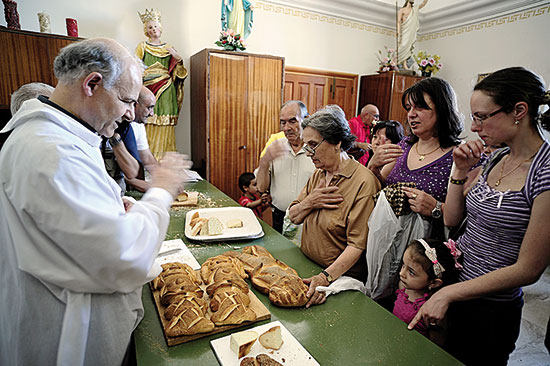 Attilio Russo Attilio RussoThe priests bless the bread offerings during mass. Then the bread is broken and distributed to the faithful before a brief procession around the sanctuary.. |
«In these orgies of bodies, limbs, organs made of bread, we can see an act of anthropophagy or –more accurately– patrophagy, and even link the rite with the holy communion» |
|
|
Ethnographic context At the heart of Vallone, in what was once the bread basin of Sicily, between the towns of Villalba and Marianopoli, we find the Bilìci sanctuary dedicated to Santissimo Crocifisso on a hill overlooking a vast valley still largely devoted to wheat. There, every year on the 3rd of May, many pilgrims come from the neighbouring villages (Villalba, Marianopoli, Vallelunga) and from even further afield (Casteltermini, Santa Caterina Villermosa, Mussomeli, Resuttano, Geraci, Petralia Sottana and Soprana, Castellana Sicula). These pilgrims come to «pi fari u viaggiu a lu Signuri»: to give thanks the Santissimo Crocifisso, begging his miraculous intervention to alleviate all bodily and spiritual ills while also requesting –once more– the promise of bountiful harvests. Many pilgrims bring offerings of bread in the shape of bodies, arms, hands, heads… which they place on a bench for this purpose in the church. The bread is blessed during Mass, and then it is broken and shared among the faithful before a brief procession around the sanctuary. As soon as the venerable cross appears at the church door, the faithful cry: «Viva, viva u Santissimu Crucifissu!» and someone hails: «Oh, Santissimu nostru Crucifissu! Misericordia! Pani e paradisu!». This chant is similar to the one ringing out at Geraci, «Pani e Paradisu! Piatà e misiricordia, Signuri!» whose meaning we could essentially explain with an ancient farmers’ saying: «We have always worked the land, the land belongs to the Lord, and in him we trust». Here we will not go into the articulated ritual sequence that characterises the pilgrimage and festival, a rite that is still very much alive, nor the very reasons for its creation. However, we must emphasise that the 3rd of May, festival celebrated to worship the Holy Cross and –as is common in Sicily– to worship Christ crucified upon the cross, is also the time of other events that directly concur with these calendar dates. Thus, in May, the ears of wheat are about to complete the ripening process, coinciding with unforeseen atmospheric events (the sirocco, storms…) which can endanger a year’s work when it is about to be completed: only the divine can safeguard it from doom. Moreover, there is unquestionable evidence demonstrating that, in fact, production cycles and social life define the meaning, functions and symbolic content related to festivals, in principle, and not the specific milestones marked by the liturgical calendar. In Barrafranca, for example, also held on the 3rd of May is the festival of Saint Alexander, patron saint of the city, who is offered votive bread offerings too. These also take the form of human figures, either whole or just heads, arms, legs… brought by the faithful, who from the early hours start flocking to the church to participate in the Eucharistic celebrations taking place throughout the morning. As in the case of the numerous ceremonies dedicated to the Holy Cross, the relationship between the patron saint of Barrafranca and heavenly grain is apparent in other symbols comprising these rituals. Among these are the sheaves of wheat that still adorn the processional biers, for example. Indeed, until recently, the icon of Saint Alexander was hoisted shoulder-high to the edge of the village and carried along paths made between rolling cornfields. Farmers explicitly left these routes open to invoke a successful harvest. The fact that religious ceremonies are held at this crucial phase of production is not unusual, considering that the traditional Sicilian ceremonial calendar and associated ritual symbols, including bread, highlight its close relationship with the most important point in the wheat-growing cycle. On the 18th of June, during tiempu i San Caloiaru a season beginning in May –with the first horticultural fruits, the ripening of produce, the promise of abundance– and lasting until the start of reaping in the harvest, in Naro hundreds of devotees flock to the San Calogero urban sanctuary. They come from the municipality and nearby towns (Canicattì, Delia, Sommatino), sometimes after a long pilgrimage barefoot, to bring wheat and anthropomorphic bread figures, with requests for healing. The breads, called pupi (puppets) there, represent whole bodied people or, more rarely, organs or body parts. Pilgrims bearing offerings are received by priests at a long table next to the sanctuary. After the blessing, the bread figures are cut into slices and shared among the faithful, who gather around to catch the pieces, which they eat after having recited a short prayer, or keep it to take home to relatives or friends. Much of the bread is collected in large baskets for later distribution to the poor. Notably, the relationship between the saint and the harvest is apparent in the Straula, the processional bier transported by the faithful, dragged on long ropes recalling slitta, a kind of «sledge» on which the sheaves of wheat used to be transported for threshing. Bread offerings associated with processions are also typical of Campofranco in the province of Caltanissetta, where the patronal feast is celebrated in July, coinciding with the end of the traditional harvest. In Campofranco, site of a shrine dedicated to the saint, on the night of the last Sunday in July the faithful pour in –from Milena, Bompensiere, Sutera and Casteltermini– to participate in the festival the following day. Gathered in small groups, the faithful perform u viaggiu scanzu (on foot and barefoot) to fulfil their vows. And offerings they bear pupi (puppets) or San Calò breads, representing the cured body part or, more often, whole bodies of varying sizes depending on the size of the miracle believed to have been performed. These bread figures, thought holy partly due to the priest’s blessing and partly due to their proximity with the icon during the procession, are divided and eaten at the foot of the saint’s bier. So too are they taken to the village of origin and shared among neighbours and relatives. Besides the various festivals dedicated to San Calogero, votive breads representing human bodies or limbs are also to be found in the San Juan Bautista festivals in Raffadali and Aragona. In Raffadali, in particular, from the early hours of the 24th of June, the faithful flock from the villages of Sant’Elisabetta and Joppolo Giancaxio, carrying baskets of men-shaped breads, placed on trays decorated with ears of wheat and embroidered handkerchiefs. On long tables spread with white tablecloths, perfectly aligned within the church, pilgrims place the loaves: legs, arms, hands, heads, hearts… to thank San Jaun for healing them. The bread figures –home-made before but now mostly made in bakeries– are blessed during the service, after which they are eaten and distributed among relatives, friends and neighbours. Formerly a portion was crumbled in the fields to bring on a good harvest. |
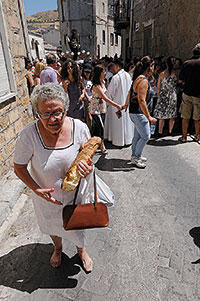 Attilio Russo Attilio RussoIt is common to turn to the saints with offerings of anthropomorphic bread figures, seeking health remedies. The picture shows a barefoot woman carrying a human-shaped votive bread during the festival of San Calogero, Campofranco (Sicily). |
|
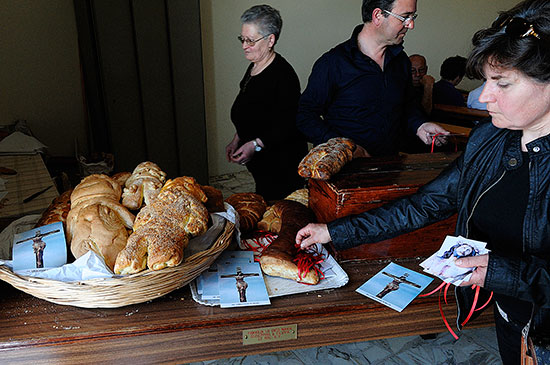 Attilio Russo Attilio RussoPilgrims carry the votive offerings to the church, where they will be blessed. The photograph shows the celebration of Santissimo Crocifisso at Castel di Bilici sanctuary (Sicily). |
«In Campofranco people offer bread representing the cured body part or, more often, whole bodies of varying sizes depending on the size of the miracle believed to have been performed» | |
|
Concluding remarks The description herein has not –by any means– exhausted the panorama of festive contexts characterised by the presence of anthropomorphic votive bread figures. Indeed, we could add the bread offerings made to San Calogero in Agrigento, Delia, Milena, Favara, San Cataldo, Sutera, Caltavuturo, Canicattì, as well as those dedicated to San Felipe de Agira in Aidone and San Rocco in Butera. In fact all these saints are offered bread in thanks for prayers answered and to fulfil the vows made: it is received to be returned and redistributed among the people, with the time of the ritual just the day after the harvest. Thus, the deeper purpose underlying the offerings of votive bread is clearly not only to give thanks, but to boost a positive cyclical exchange with the transcendental powers. This bread, donated to the saint (and with it the effort required to harvest the wheat, grind the flour, knead it, cook it, carry it in procession) is «sacred», sacred because the priest blesses it, sacred because it has touched the saint. However, rather than a sacred food, this bread is saintly power turned into food, a power that is accessible to the people, to take and exploit it to their advantage. The bread intended for the Saints is, in fact, eaten up by the people (traditionally and preferably, by a certain kind of people: the poor), as happens with sweets and vegetable soup (cuccia), prepared on occasion, and in commemoration, of the dead, so too the bread made for San Jose. Certainly, not without reason, we can see in these orgies of bodies, limbs, organs made of bread, an act of anthropophagy or –more accurately– patrophagy and we can even link the rite with the Eucharist, the sacred food of union and communion, communication between men and gods. It should be added that, ultimately, the subjects intended to eat the sacred food, namely, divinity transformed into bread, are called upon to play –sometimes explicitly– vicarious figures of the transcendent powers themselves, thus we are in fact bearing witness to an act of «self-feeding». It is the Divine that eats himself, as evidence of substantial ontological diversity and as confirmation that all creation belongs to him, that everything comes from him, that everything entering his cosmic body must return, for life to be renewed. Ignazio E. Buttitta. Chair of History of Folklore. University of Palermo (Italy). |
«Production cycles and social life define the meaning, functions and symbolic content related to festivals, in principle, and not the specific milestones marked by the liturgical calendar» | |
REFERENCES
Buttitta, A. and A. Cusumano, 1991. Pane e festa. Tradizioni in Sicilia. Guida. Palermo.
Buttitta, I. E., 2006. I morti e il grano. Tempi del lavoro e ritmi della festa. Meltemi. Rome.
Cavalvanti, O., 1995. Cibo dei vivi, cibo dei morti, cibo di dio. Rubettino. Soveria Mannelli (Cz).
Cirese, A. M. et al., 1973. Plastica effimera in Sardegna: i Pani. Regione Autonoma della Sardegna. Cagliari.
Faeta, F., 1987. «Le figure di pasta dolce in un paese rurale calabrese». La Ricerca Folklorica, 16: 117-124.
Faeta, F., 2000. Il sant e l'aquilone. Per un'antropologia dell'immaginario popolare nel secolo xx. Sellerio. Palermo.
Giallombardo, F., 2006. La festa di sant Giuseppe in Sicilia. Figure dell'alternanza e liturgie alimentari. Fondazione Ignazio Buttitta. Palermo.
Pitrè, G., 1913. La famiglia, la casa, la vita del popolo siciliano. A. Reber. Palermo.
Rossi, A., 1971. «Ex voto di Pane». Esso rivista, 3: 8-13.
Ruffino, G., 1995. I Pani di Pasqua in Sicilia. Un saggio di geografia linguistica e etnografica. Centro di Studi Filologici e Linguistici Siciliani. Palermo.
Uccello, A., 1976. Pani e dolci di Sicilia. Sellerio. Palermo.

